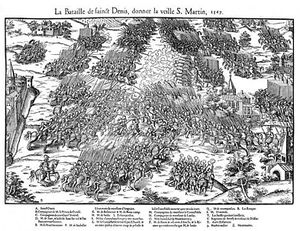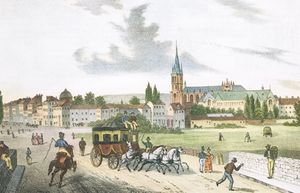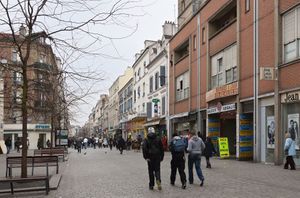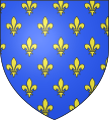سان-دني، سين-سان-دني
سان دوني | |
|---|---|
Subprefecture and commune | |
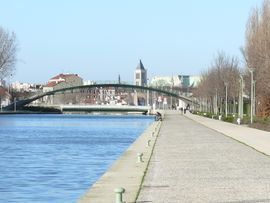 | |
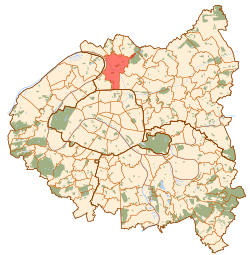 Paris and inner ring departments | |
Paris and inner ring departments | |
| الإحداثيات: 48°56′08″N 2°21′14″E / 48.9356°N 2.3539°E | |
| البلد | فرنسا |
| المنطقة | إيل دو فرانس (منطقة) |
| الإقليم | Seine-Saint-Denis |
| الدائرة | سان-دوني |
| الكانتون | Saint-Denis-1 and 2 |
| بينالتجمعات | Grand Paris |
| الحكومة | |
| • العمدة (2020–2026) | Mathieu Hanotin[1] |
| المساحة 1 | 12٫36 كم² (4٫77 ميل²) |
| التعداد | 112٬852 |
| • الكثافة | 9٬100/km2 (24٬000/sq mi) |
| منطقة التوقيت | UTC+01:00 (CET) |
| • الصيف (التوقيت الصيفي) | UTC+02:00 (CEST) |
| INSEE/الرمز البريدي | 93066 /93200, 93210 (La Plaine) |
| المنسوب | 23–46 m (75–151 ft) |
| الموقع الإلكتروني | ville-saint-denis.fr |
| 1 French Land Register data, which excludes lakes, ponds, glaciers > 1 km2 (0.386 sq mi or 247 acres) and river estuaries. | |
سان دوني (النطق الفرنسي: [sɛ̃.d(ə).ni]، Saint-Denis)، هو كميون في ضواحي باريس الشمالية، فرنسا. يقع كميون سان دوني على بعد 9.4 كم من وسط باريس. سان دوني هي قسم فرعي من اقليم سين-سان دوني، ومقعد دائرة سان دوني.
تضم سان دوني المقابر الملكي لكنيسة سان دوني وكانت أيضاً موقع للمصلى التابع له. وتضم أيضاً الملعب الوطني لكرة القدم والرگبي، استاد فرنسا، الذي بُني لاستضافة منافسات كأس العالم لكرة القدم 1998.
سان دوني هي ضاحية صناعية سابقة والتي أعيد تحويلها حالياً إلى قاعدة صناعية ويطلق على أهالي سان دوني سان دونيون.[3]
خلال عام 1990، بدأت المدينة في النمو والتوسع وذلك بسبب الهجرة الكثيفة إليها، في عام 1998 قامت بطولة كائس العالم لكرة القدم في أراضيها على استاد فرنسا، وتطورت المدينة بتقديم الكثير من تحسينات البنية التحتية، مثل تمديد المترو في المدينة.
الاسم
Until the 3rd century, Saint-Denis was a small settlement called Catolacus or Catulliacum, probably meaning "estate of Catullius", a Gallo-Roman landowner. About 250 AD, the first bishop of Paris, Saint Denis, was martyred on Montmartre hill and buried in Catolacus. Shortly after 250 AD, his grave became a shrine and a pilgrimage centre, with the building of the Abbey of Saint Denis, and the settlement was renamed Saint-Denis.
In 1793, during the French Revolution, Saint-Denis was renamed Franciade in a gesture of rejection of religion. In 1803, however, under the Consulate of Napoléon Bonaparte, the city reverted to its former name of Saint-Denis.
التاريخ
حتى فترة القرن الثالث الميلادي كانت المدينة تسمى ب كاتولكوس أو كاتكولياكوم وهي كلمة لاتينية تعني الحوزة، وربما أُطلق عليها كاتكوليام لاسم صاحب الأرض الي كان فيها. سميت المدينة باسم سان دوني نسبة إلى القديس سانت دونيس أو سان دوني الذي استشهد في أراضيها حوالي عام 250 في منطقة مونمارتر ودفن في التلة التي بنيت عليها كاتدرائية سان دوني، ليصبح قبره مزاراً ومركزاً للحج. غير اسم المدينة في عام 1793 من سان دوني إلى فرانسياد في عهد الثورة الفرنسية لأنها تحمل اسم ديني وفي لفتة من الرفض للدين في أفكار الثورة، ولكن في عام 1803 استعادت المدينة اسمها السابق سان دوني بأمر من القائد نابليون بونابرت.
During its history, Saint-Denis has been closely associated with the French royal house. Starting from Dagobert I (c. 603–639), almost every French king was buried in the Basilica.
However, Saint-Denis is older than that. In the 2nd century, there was a Gallo-Roman village named Catolacus on the location that Saint-Denis occupies today. Saint Denis, the first bishop of Me saint of France, was martyred in about 250 AD and buried in the cemetery of Catolacus. Denis' tomb quickly became a place of worship. Around 475 AD, Sainte Geneviève had a small chapel erected on Denis' tomb, which by then had become a popular destination for pilgrims. It was this chapel that Dagobert I had rebuilt and turned into a royal monastery. Dagobert granted many privileges to the monastery: independence from the bishop of Paris, the right to hold a market, and, most importantly, he was buried in Saint-Denis; a tradition which was followed by almost all his successors. During the Middle Ages, because of the privileges granted by Dagobert, Saint-Denis grew to become very important. Merchants from all over Europe (and indeed from the Byzantine Empire) came to visit its market.
In 1140, Abbot Suger, counselor to the King, granted further privileges to the citizens of Saint-Denis. He also started the work of enlarging the Basilica of Saint Denis that still exists today, often cited as the first example of high early Gothic Architecture.[4][5] The new church was consecrated in 1144.
Saint-Denis was depopulated in the Hundred Years' War; of its 10,000 citizens, only 3,000 remained after the war.
During the French Wars of Religion, the Battle of Saint-Denis was fought between Catholics and Protestants on 10 November 1567. The Protestants were defeated, but the Catholic commander Anne de Montmorency was killed. In 1590, the city surrendered to Henry IV, who converted to Catholicism in 1593 in the abbey of Saint-Denis.
King Louis XIV (1638–1715) started several industries in Saint-Denis: weaving and spinning mills and dyehouses. His successor, Louis XV (1710–1774), whose daughter was a nun in the Carmelite convent, took a lively interest in the city: he added a chapel to the convent and also renovated the buildings of the royal abbey.
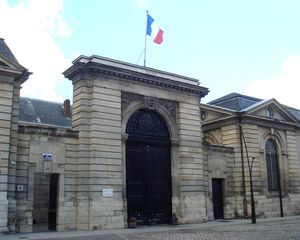
During the French Revolution, not only was the city renamed "Franciade" from 1793 to 1803, but the royal necropolis was looted and destroyed. The remains were removed from the tombs and thrown together; during the French Restoration, since they could not be sorted out anymore, they were reburied in a common ossuary.
The last king to be interred in Saint-Denis was Louis XVIII (1755 – 1824). After France became a republic and an empire, Saint-Denis lost its association with royalty.
On 1 January 1860, the city of Paris was enlarged by annexing neighbouring communes. On that occasion, the commune of La Chapelle-Saint-Denis was disbanded and divided between the city of Paris, Saint-Denis, Saint-Ouen, and Aubervilliers. Saint-Denis received the north-western part of La Chapelle-Saint-Denis.
During the 19th century, Saint-Denis became increasingly industrialised. Transport was much improved: in 1824 the Canal Saint-Denis was constructed, linking the Canal de l'Ourcq in the northeast of Paris to the River Seine at the level of L'Île-Saint-Denis, and in 1843 the first railway reached Saint-Denis. By the end of the century, there were 80 factories in Saint-Denis.
The presence of so many industries also gave rise to an important socialist movement. In 1892, Saint-Denis elected its first socialist administration, and by the 1920s, the city had acquired the nickname of la ville rouge, the red city. Until Jacques Doriot in 1934, all mayors of Saint-Denis were members of the Communist Party.
During the Second World War, after the defeat of France, Saint-Denis was occupied by the Germans on 13 June 1940. There were several acts of sabotage and strikes, most notably on 14 April 1942 at the Hotchkiss factory. After an insurgency which started on 18 August 1944, Saint-Denis was liberated by the 2nd Armored Division (France) on 27 August 1944.
After the war, the economic crisis of the 1970s and 1980s hit the city, which was strongly dependent on its heavy industry.
During the 1990s, however, the city started to grow again. The 1998 FIFA World Cup provided an enormous impulse; the main stadium for the tournament, the Stade de France, was built in Saint-Denis, along with many infrastructural improvements, such as the extension of the metro to Saint-Denis-Université. The stadium is used by the national football and rugby teams for friendly matches. The Coupe de France, Coupe de la Ligue and Top 14 final matches are held there, as well as the Meeting Areva international athletics event.
Since 2000, Saint-Denis has worked with seven neighbouring communes (Aubervilliers, Villetaneuse, Pierrefitte-sur-Seine, Épinay-sur-Seine, L'Île-Saint-Denis (since 2003), Stains (since 2003), and La Courneuve (since 2005)) in Plaine Commune.
In 2003, together with Paris, Saint-Denis hosted the second European Social Forum.
On 13–14 November 2015, Saint-Denis was the main location of a series of mass shootings and hostage-takings just outside the Stade de France. On 18 November, a major follow-up raid occurred. Several suspects were killed, including alleged mastermind Abdelhamid Abaaoud.[6]
In 2016, Saint-Denis was one of the host cities of the UEFA European Football Championships, including the opening game.[7]
الدروع
الديموغرافيا
يبلغ عدد سكان المدينة حوالي 101.880 حسب إحصائيات عام 2008، والكثافة السكانية تبلغ معدل (21،350 نسمة/للميل مربع الواحد).
الهجرة
| |||||||||||||||||||
المغاربة
النقل

الجريمة
التعليم
مشاهير سان دوني
- Nakibou Aboubakari، لاعب كرة قدم
- Sami Ameziane, humourist (fr)
- Jean-Christophe Bahebeck، لاعب كرة قدم
- Paule Baudouin، لاعب كرة يد
- Maurice Beyina، لاعب كرة سلة
- Thievy Bifouma، لاعب كرة قدم
- Franck Chantalou, karateka
- Vincent Clarico، لاعب ألعاب قوى
- Angelo Debarre، موسيقي
- Pierre Degeyter، ملحن
- Charles Dezobry، مؤلف
- Phousseyne Diaby، لاعب كرة قدم
- پول إيلوار، شاعر
- fr، عمدة
- Jean-Marc Grava، لاعب ألعاب قوى
- Auriol Guillaume، لاعب كرة قدم
- Abdelaziz Kamara، لاعب كرة قدم
- Vasseko Karamoko، لاعب كرة قدم
- Jonathan Kodjia، لاعب كرة قدم
- Moussa Koita، لاعب كرة قدم
- Albert Lebourg، رسام
- Loic Lumbilla، لاعب كرة قدم
- Rosere Manguelle، لاعب كرة قدم
- كلود موني، رسام
- fr، رسام
- Rodrigue Nordin، لاعب ألعاب قوى
- Sabrina Ouazani، ممثلة
- Francisque Poulbot، خطاط
- Michael Raffaelli، رسام
- Yannis Salibur، لاعب كرة قدم
- Kool Shen، لص (Suprême NTM)[8]
- پول سينياك، رسام
- William Soliman، لاعب كرة سلة
- Joey Starr، لص (Suprême NTM)[8]
- Brahim Thiam، لاعب كرة قدم
- Alassane Toure، لاعب كرة قدم
- Alioune Toure، لاعب كرة قدم
- Yannick Urbino، لاعب ألعاب قوى
- Maurice Utrillo، رسام
المعالم الرئيسية
العلاقات الدولية
المدن الشقيقة
سان دوني على توأمة مع:
المصادر
- ^ "Répertoire national des élus: les maires". data.gouv.fr, Plateforme ouverte des données publiques françaises (in French). 2 December 2020. Retrieved 7 December 2020.
{{cite web}}: CS1 maint: unrecognized language (link) - ^ "Insee - Populations légales 2012 - 93-Seine-Saint-Denis". insee.fr.
- ^ "Saint-Denis - Habitants". habitants.fr.
- ^ Rolf, Toman (ed.) (2004). Der Gothisch. Ullmann & Könemann
- ^ Swaan, Wim (1969). The Gothic Cathedral
- ^ Irish, John; Blachier, Gregory (19 November 2015). "'Spider in web' mastermind of Paris attacks killed in raid". Reuters. Retrieved 20 November 2015.
- ^ "Saint-Denis getting in the mood for EURO". UEFA.com. 13 June 2015.
- ^ أ ب Gross, Joan, David McMurray, and Ted Swedenburg. "Arab Noise and Ramadan Nights: Rai, Rap, and Franco-Maghrebi Identities" (Anthropology: Postcolonial Studies). In: Lavie, Smadar and Ted Swedenburg. Displacement, Diaspora, and Geographies of Identity. Duke University Press, 1996. ISBN 0822317206, 9780822317203. p. 1پول سينياك42.
قراءات إضافية
- Hirji, Shazmin. "Outside Paris" (Archive). The Harvard Crimson. September 13, 2012. - Opinion section
وصلات خارجية
- INSEE (إنگليزية)
- City council website (بالفرنسية)
- Saint-Denis, a town in the Middle Ages (إنگليزية)




